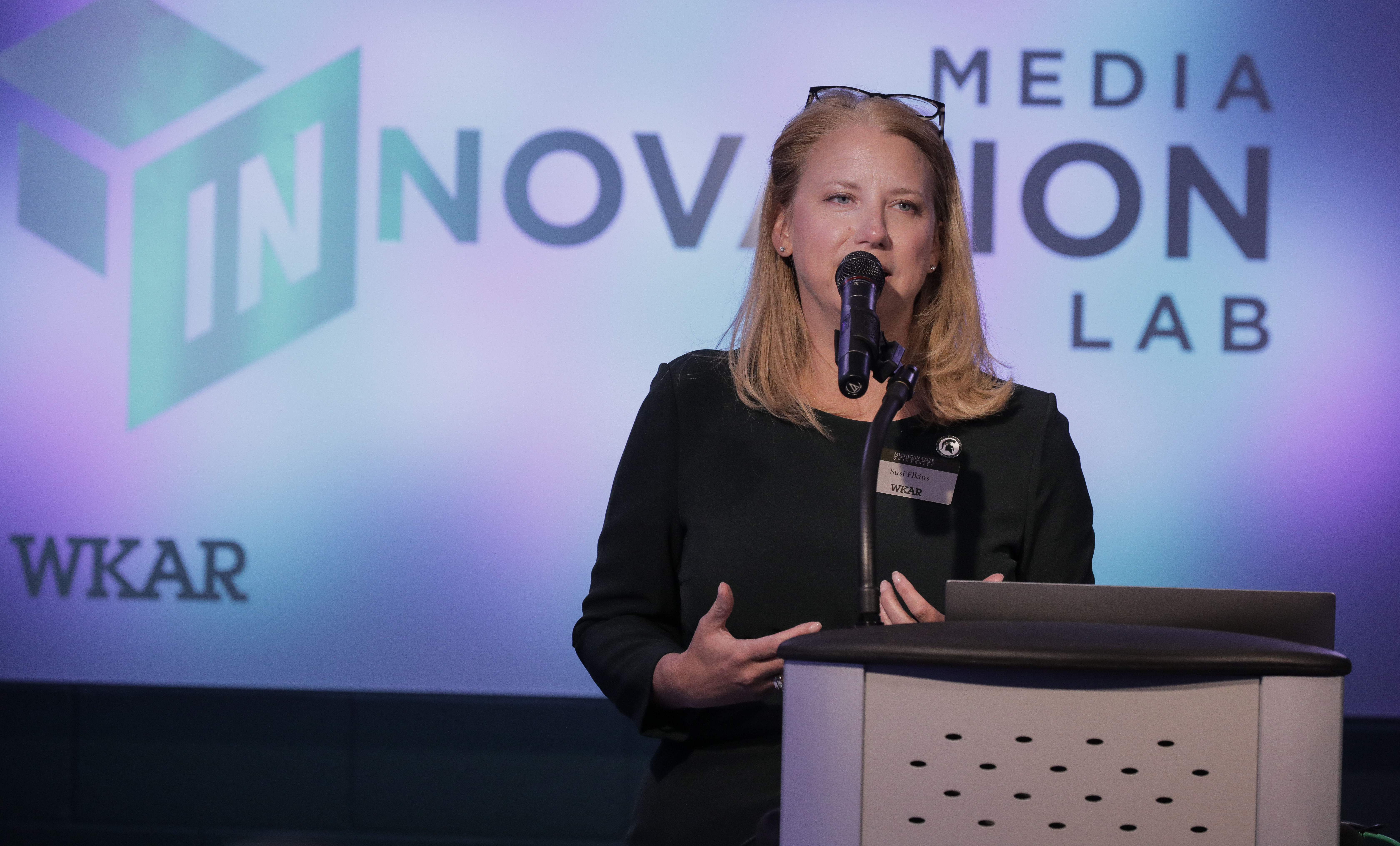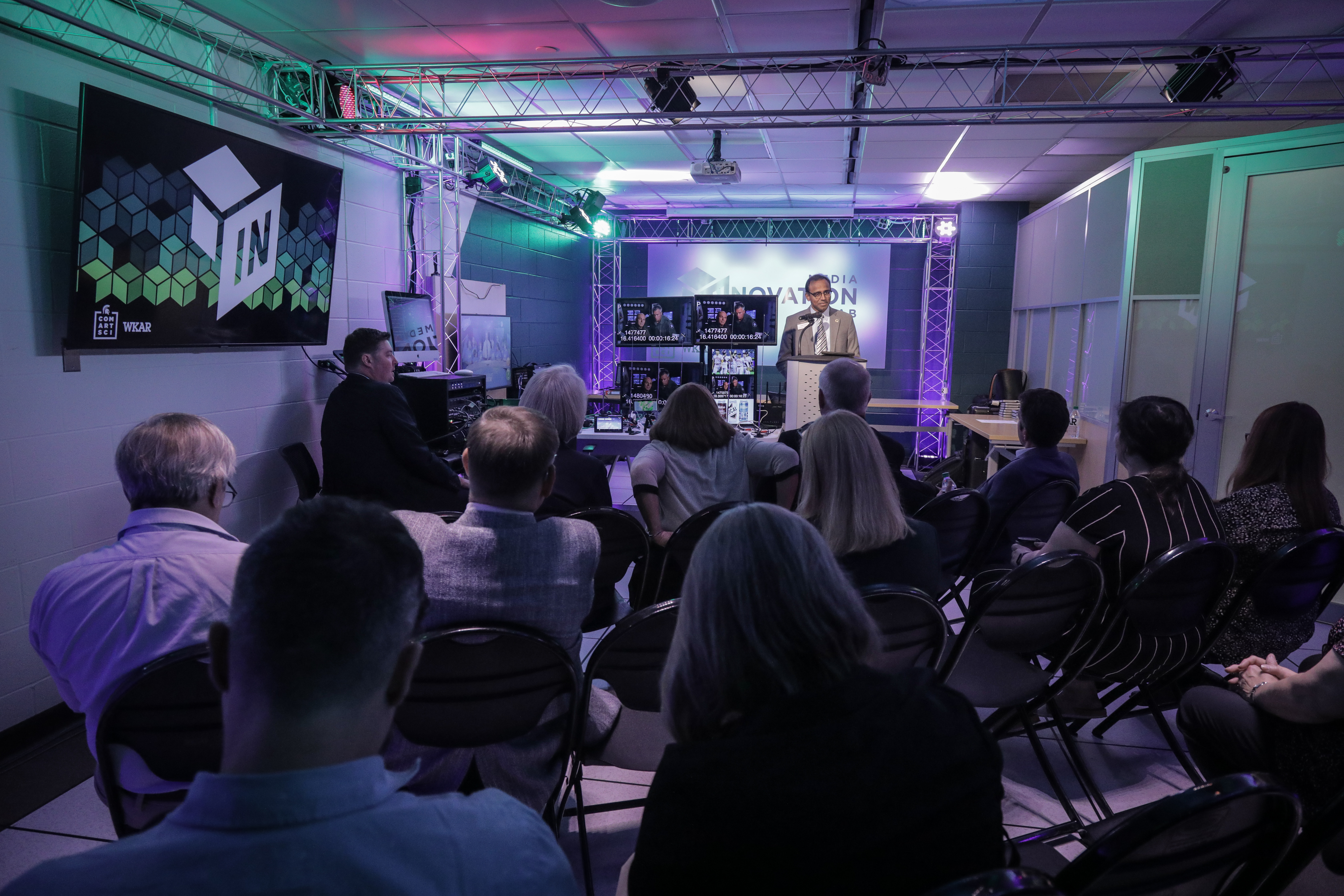ATSC 3.0 Technology Combines Broadcast and Broadband, Expanding Potential for Education, Mobility, Emergency Alert Systems, Telemedicine and More
WKAR Public Media, Michigan State University and the College of Communication Arts and Sciences opened the NextGen Media Innovation Lab on Thursday, Sept. 19. The new lab will explore applications of the newest television broadcasting standard, ATSC 3.0 technology, or NextGen TV.
“This innovative space serves as a collaborative hub where students, faculty and researchers will explore the future of television and other applications afforded by the emerging ATSC 3.0 digital standard,” said Susi Elkins, Director of Broadcasting and General Manager, WKAR Public Media. “We’ve reached several significant milestones since receiving our experimental license last year and are excited to reach this goal of launching the NextGen Media Innovation Lab.”
During the opening ceremony, MSU President Samuel Stanley Jr., M.D., stood with Lonna Thompson, Prabu David, Fred Engel, and Elkins to cut the ribbon for the NextGen Media Innovation Lab. The event was preceded by demonstrations on NextGen TV and emerging technology and followed by a tour of Spartan Mobility Village.
“WKAR has a long history of innovation in programming,” said Stanley. “This NextGen Media Innovation Lab is a true twenty-first century manifestation of the land grant tradition at MSU, building innovation and community research into an educational program.”
In 2018, WKAR was the first public broadcasting station in the U.S. to be granted an experimental license by the FCC to broadcast in ATSC 3.0 technology, or NextGen TV. To develop the new technology, the NextGen Media Innovation Lab was constructed inside WKAR studios, located at MSU’s College of Communication Arts and Sciences.
“WKAR is doing amazing things here, through MSU,” said Lonna Thompson, Executive Vice President, Chief Operating Officer and General Counsel, American Public Television Stations. She said WKAR was the first public broadcasting station to step forward and embrace the emerging technology of NextGen TV. “WKAR became the model for the rest of our stations across the country.”
Combining the capabilities of broadcast technology and high-speed internet, NextGen TV offers broadcasters a way to distribute highly customized, accessible and interactive content over the airwaves. The technology allows audiovisual broadcasts to be customized by geographic location and displayed with multiple screens, providing television, mobile applications, and targeted messaging to customers simultaneously on one device.

“The new standard integrates broadcast with broadband, and features heightened mobility and a more efficient use of the broadcast spectrum,” said Elkins. “These attributes allow numerous opportunities for multidisciplinary research on customization and interactivity.”
With the help of researchers and developers, NextGen TV holds the potential to deliver innovations in a wide range of services, including education, automotive technology, advanced emergency alert systems, telemedicine and marketing, to name a few.
“NextGen TV holds transformational opportunities for public media and how we approach our public safety and education missions,” said Fred Engel, Senior Director of Technology for UNC-TV North Carolina. “In particular, UNC-TV believes this technology can save lives, by allowing us to alert public safety first-responders far more quickly and with far greater detail than we’re able to do now. The creation of this lab highlights WKAR’s commitment to cutting-edge research, and UNC-TV is proud to share that commitment.”
Because data can be delivered alongside traditional television content via a free, over-the-air broadcast signal, the technology can also reach underserved populations and people who live in rural areas. The Trifecta Initiative, a health research collaboration between the colleges of Engineering, Nursing, and Communication Arts and Sciences, held a challenge in the spring to collect innovative ideas to leverage the capabilities of ATSC 3.0.

Now, the NextGen Media Innovation Lab is open for collaboration, research and development. Faculty, staff, students and partners will be further exploring ideas for innovation, and creating some of the first applications for NextGen TV.
“This is truly impressive technology,” said Prabu David, Dean of the College of Communication Arts and Sciences. “What I am most excited about is the technology offers numerous opportunities to serve our land grant mission, but also the mission of public television, which is to provide access to those that don’t have it.”
By Melissa Priebe
